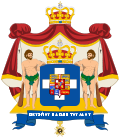George II of Greece
|
||||||||||||||||||||||||||||||||
|
||||||||||||||||||||||||||||||||
George II, King of the Hellenes (Greek: Γεώργιος Β', Βασιλεύς των Ελλήνων) (19 July/20 July 1890 - 1 April 1947) ruled Greece from 1922 to 1924 and from 1935 to 1947.
Contents |
Early life, first period of kingship and exile
George was born at the royal villa at Tatoi, near Athens, the eldest son of Constantine I, King of the Hellenes and his wife, Princess Sophia of Prussia. He was a great-grandson of Queen Victoria and grandson of George I of Greece, the Danish prince of Glucksburg who had been selected as King in 1863. He was a direct descendant of five Greek imperial (Byzantine) dynasties (Monomachos, Comnenos, Laskaris, Angelos, and Paleologos).[1] George pursued a military career, training with the Prussian Guard at the age of 18, then serving in the Balkan War as a member of the 1st Greek Infantry. When his grandfather was assassinated in 1913, George became the crown prince (Diadochos) as well as the Duke of Sparta.
After a coup deposed King Constantine during the First World War, Crown Prince George, by then a Major, followed his father into exile in 1917 (see National Schism); his brother Alexander was installed as a puppet ruler by prime minster Eleftherios Venizelos.
When Alexander I died following an infection from a monkey bite in 1920, Venezelos was voted out of office, and a plebiscite restored Constantine to the throne. Crown Prince George served as a colonel, and later a major general in the war against Turkey. During this time he married, on 27 February 1921 in Bucharest, Princess Elisabeth of Romania, daughter of King Ferdinand I of Romania and Princess Marie of Edinburgh. When the Turks defeated Greece at the Battle of Smyrna, the military forced the abdication of Constantine, and George succeeded to the Greek throne on September 27 1922.
Following a failed royalist coup (by Ioannis Metaxas) in October 1923, the Revolutionary Committee "asked" him to depart Greece while the National Assembly considered the question of the future form of government. He complied and, although he refused to abdicate, he left on December 19, 1923 for exile in his wife's home nation of Romania. When a republic was proclaimed on March 25 1924, he was officially deposed, stripped of his Greek nationality and his property confiscated.[2]
His wife stayed in Bucharest whilst he spent more and more time abroad visiting Britain, and his mother in Florence. In 1932 he left Romania permanently and moved to Britain.[3] Elisabeth and he had no children, and were divorced on July 6 1935.
Restoration of monarchy and the Metaxas regime
In Greece between 1924 and 1935 there were 23 changes of government, a dictatorship and 13 coups. General Georgios Kondylis, a former Venizelist, overthrew the government in October 1935 and appointed himself Prime Minister. He then arranged a plebiscite both to approve his government and to bring an end to the Republic. On November 3 1935, over 95% of the reported votes supported restoration of the monarchy.[4] The balloting was not secret, and participation was compulsory. As Time magazine described it at the time, "A voter one could drop into the ballot box a blue vote for George II and please General George Kondylis... or one could cast a red ballot for the Republic and get roughed up."[5]
George, who had been living at Brown's Hotel in London, returned to Greek soil on November 25. Almost immediately he and Kondylis disagreed over the terms of a general amnesty the King wanted to declare, and George appointed an interim Prime Minister, Professor Konstantinos Demertzis. New elections were held in January, which resulted in a hung parliament with the Communists (who were anti-monarchist) holding the balance of power. A series of unexpected deaths amongst the better-known politicians (including Kondylis and Demertzis) as well as the uncertain political situation, led to the rise to power of Ioannis Metaxas. On August 4, 1936, George endorsed Metaxas's establishment of dictatorship - the "4th of August Regime",[6] signing decrees that dissolved the parliament, banned political parties, abolished the constitution, and created a "Third Hellenic Civilization.[7] The King, ruling with Prime Minister Metaxas, oversaw a fascist regime in which political opponents were arrested and strict censorship was imposed. An Index of banned books during that period included the works of Plato, Thucydides and Xenophon.[7]
World War II
Despite the regime's quasi-fascist tendencies and strong economic ties to Nazi Germany, King George was known to have pro-British feelings at the start of World War II. On October 28 1940 Metaxas rejected an Italian ultimatum demanding the stationing of Italian troops in Greece, and Italy invaded, starting the Greco-Italian War. The Greeks mounted a successful defense and eventually occupied the southern half of Albania, but when the Germans invaded from Bulgaria on April 6 1941 the Greeks and the British Expeditionary Force were overrun, and mainland Greece occupied.[8]
On April 23 the King and the government left the Greek mainland for Crete but after the German airborne attack on the island he was evacuated to Egypt. Once again he went into exile to Great Britain, seemingly at the behest of King Farouk of Egypt and Farouk's pro-Italian ministers.[9]
During the war he remained the internationally recognized head of state, backed by the exiled government and Greek forces serving in the Middle East. In occupied Greece, however, the leftist partisans of the National Liberation Front (EAM) and National Popular Liberation Army (ELAS), now unfettered by Metaxas' oppression, had become the largest Greek Resistance movement, enjoying considerable popular support. As liberation drew nearer, however, the prospect of the King's return caused dissensions both inside Greece and among the Greeks abroad. Although the King effectively renounced the Metaxas regime in a radio broadcast, a large section of the people and many politicians rejected his return on account of his support of the dictatorship. In November 1943 George wrote to the Prime Minister-in-exile Emmanouil Tsouderos, "I shall examine anew the question of the date of my return to Greece in agreement with the Government". Either deliberately or accidentally, the version released for publication omitted the words "of the date", creating the impression that George had agreed to a further plebiscite on the monarchy, even though a retraction was issued.[10]
After two changes of Prime Minister, the establishment of a rival Communist-led government in occupied Greece and a pro-EAM mutiny among the armed forces in the Middle East, it was agreed in the May 1944 Lebanon conference that the fate of the monarchy would be decided in a national referendum. Bowing to Allied pressure, George was forced to appoint Archbishop Damaskinos of Athens as Regent in January 1945. Damaskinos immediately appointed a republican-dominated government. Being ill, exhausted and powerless, George bought a lease on a house in Chester Square, Belgravia and made a home there with his long-time mistress.[11]
Return to Greece and death
In elections held on March 31 1946 the monarchist parties won a clear majority of the parliamentary seats, aided by the abstention of the Communists, and the referendum on the monarchy was set for September 1. Between then and the plebiscite, the electoral registers were revised under Allied supervision. The announced results claimed 69% in favour of the King's return on a 90% turnout.[12] The result fueled Civil War between the communists and the royalists (see Greek Civil War).
On 26 September George returned to Greece to find the Royal Palace looted, the woods at Tatoi chopped down for fuel and corpses buried in shallow graves outside.[13] His country faced economic collapse and political instability.
On 31 March 1947 he was discovered unconscious in his room at the Royal Palace in Athens, and died the following day of arteriosclerosis. When the news was announced some thought it to be an April Fool's joke.[14]
His funeral was held at the Orthodox Cathedral of the Annunciation in Athens.
He was succeeded by his brother, Paul. On account of his many exiles, he is said to have remarked that "the most important tool for a King of Greece is a suitcase."[15]
Honours, styles and arms
In 1941, he was awarded the Distinguished Service Order for courage under enemy fire, the only time a reigning Monarch has received this decoration.
In 1942, he was awarded the Norwegian War Cross.
In Greece he was honored by having a stamp made after him.
Ancestry
| Ancestors of George II of Greece | ||||||||||||||||||||||||||||||||||||||||||||||||||||||||||||||||||||||||||||||||||||||||||||||||||||||||||||||||||||||||||||||||||||||||||||||||||||||||||||||||||||||||||||||||||||||||||||||||||||||||||||||||||||||||||||||||||||||||||||||||||||||||||||||||||||||||||||||||||||||||||||||||||||||||||||||||||||||||||||||||||||||||||||||||||||||||||||||||||||||||||||||||||||||||||||||||||||||||||||||||||||||||||||||||||||||||||||||||||||||||||||||||||||||||||||||||||||||||||||||||||||||||||||||||||||||||||||||||||||||||||||||||||||||||||||||||||
|---|---|---|---|---|---|---|---|---|---|---|---|---|---|---|---|---|---|---|---|---|---|---|---|---|---|---|---|---|---|---|---|---|---|---|---|---|---|---|---|---|---|---|---|---|---|---|---|---|---|---|---|---|---|---|---|---|---|---|---|---|---|---|---|---|---|---|---|---|---|---|---|---|---|---|---|---|---|---|---|---|---|---|---|---|---|---|---|---|---|---|---|---|---|---|---|---|---|---|---|---|---|---|---|---|---|---|---|---|---|---|---|---|---|---|---|---|---|---|---|---|---|---|---|---|---|---|---|---|---|---|---|---|---|---|---|---|---|---|---|---|---|---|---|---|---|---|---|---|---|---|---|---|---|---|---|---|---|---|---|---|---|---|---|---|---|---|---|---|---|---|---|---|---|---|---|---|---|---|---|---|---|---|---|---|---|---|---|---|---|---|---|---|---|---|---|---|---|---|---|---|---|---|---|---|---|---|---|---|---|---|---|---|---|---|---|---|---|---|---|---|---|---|---|---|---|---|---|---|---|---|---|---|---|---|---|---|---|---|---|---|---|---|---|---|---|---|---|---|---|---|---|---|---|---|---|---|---|---|---|---|---|---|---|---|---|---|---|---|---|---|---|---|---|---|---|---|---|---|---|---|---|---|---|---|---|---|---|---|---|---|---|---|---|---|---|---|---|---|---|---|---|---|---|---|---|---|---|---|---|---|---|---|---|---|---|---|---|---|---|---|---|---|---|---|---|---|---|---|---|---|---|---|---|---|---|---|---|---|---|---|---|---|---|---|---|---|---|---|---|---|---|---|---|---|---|---|---|---|---|---|---|---|---|---|---|---|---|---|---|---|---|---|---|---|---|---|---|---|---|---|---|---|---|---|---|---|---|---|---|---|---|---|---|---|---|---|---|---|---|---|---|---|---|---|---|---|---|---|---|---|---|---|---|---|---|---|---|---|---|---|---|---|---|---|---|---|---|---|---|---|---|---|---|---|---|---|---|---|---|---|---|---|---|---|---|---|---|---|---|---|---|---|---|---|---|---|---|---|---|---|---|---|---|---|---|---|---|---|---|---|---|---|---|---|---|---|---|---|---|---|---|---|---|---|---|---|---|---|---|---|---|---|---|---|---|---|---|---|---|---|---|---|---|---|---|---|---|---|---|---|---|---|---|---|---|---|---|---|---|---|---|---|---|---|---|---|---|---|---|---|---|---|---|---|---|---|---|---|---|---|---|---|---|---|---|---|
|
||||||||||||||||||||||||||||||||||||||||||||||||||||||||||||||||||||||||||||||||||||||||||||||||||||||||||||||||||||||||||||||||||||||||||||||||||||||||||||||||||||||||||||||||||||||||||||||||||||||||||||||||||||||||||||||||||||||||||||||||||||||||||||||||||||||||||||||||||||||||||||||||||||||||||||||||||||||||||||||||||||||||||||||||||||||||||||||||||||||||||||||||||||||||||||||||||||||||||||||||||||||||||||||||||||||||||||||||||||||||||||||||||||||||||||||||||||||||||||||||||||||||||||||||||||||||||||||||||||||||||||||||||||||||||||||||||
References
- ↑ Royal and Noble Genealogical Data on the Web
- ↑ John Van der Kiste (1994). Kings of the Hellenes. Stroud, Gloucestershire: Alan Sutton Publishing. pp. p.144. ISBN 0-7509-0525-5.
- ↑ Van der Kiste, p.145-146
- ↑ Van der Kiste, p.153
- ↑ "By the Grace of God," TIME Magazine, November 18, 1935
- ↑ Van der Kiste, p.154-156
- ↑ 7.0 7.1 Current Biography 1943, pp225-29
- ↑ Van der Kiste, p.161-162
- ↑ Van der Kiste, p.164
- ↑ Van der Kiste, p.165-167
- ↑ Van der Kiste, p. 171
- ↑ Van der Kiste, p.172
- ↑ Van der Kiste, p.173
- ↑ Van der Kiste, p.175
- ↑ Anthony Beevor (2004). Crete: The Battle and the Resistance. Athens: Govostis Pub.. pp. p.104. ISBN 960-270-927-8.
|
George II of Greece
House of Schleswig-Holstein-Sonderburg-Glücksburg
Cadet branch of the House of Oldenburg
Born: 20 July 1890 Died: 1 April 1947 |
||
| Regnal titles | ||
|---|---|---|
| Preceded by Constantine I |
King of the Hellenes 27 September1922 – 25 March1924 |
Vacant
Monarchy abolished
Title next held by
Himself |
| Vacant
Republican period
Title last held by
Himself |
King of the Hellenes 3 November1935 – 1 April1947 |
Succeeded by Paul |
External links
|
||||||||||||||||||||||||||
|
|||||||||||||||||
|
|||||||||||||||||||||||


